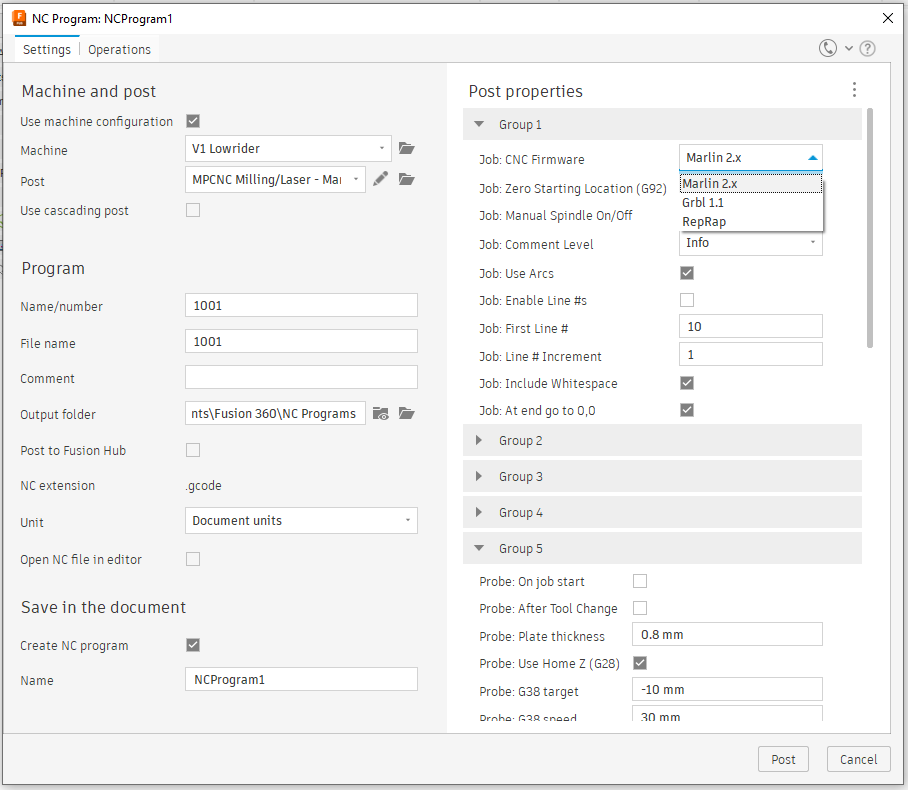Displays completion message on the controller (M117 Usinagem completa).
POST PROCESSOR:
+===========================================================================
|
| gCode - Vectric machine output post-processor for vCarve and Aspire
|
+===========================================================================
POST_NAME = “Marlin MPCNC Manual Spindle (*.gcode)”
FILE_EXTENSION = “gcode”
UNITS = “mm”
SUBSTITUTE = “([91])[93]”
RAPID_PLUNGE_TO_STARTZ = “YES”
LINE_ENDING = “[10]”
LINE_NUMBER_START = 0
LINE_NUMBER_INCREMENT = 1
LINE_NUMBER_MAXIMUM = 999999
VAR LINE_NUMBER = [N|A|N|1.0]
VAR CUT_RATE = [FC|C|F|1.0]
VAR PLUNGE_RATE = [FP|C|F|1.0]
VAR X_POSITION = [X|C| X|1.3]
VAR Y_POSITION = [Y|C| Y|1.3]
VAR Z_POSITION = [Z|C| Z|1.3]
VAR X_LENGTH = [XLENGTH|A||1.0]
VAR Y_LENGTH = [YLENGTH|A||1.0]
VAR Z_LENGTH = [ZLENGTH|A||1.0]
VAR Z_MIN = [ZMIN|A||1.0]
VAR SAFE_Z_HEIGHT = [SAFEZ|A||1.3]
VAR DWELL_TIME = [DWELL|A|S|1.2]
±--------------------------------------------------------------------------
| Start of file output
±--------------------------------------------------------------------------
begin HEADER
“; [TP_FILENAME]”
“; Material size: [YLENGTH] x [XLENGTH] x [ZMIN]mm”
“; Paths: [TOOLPATHS_OUTPUT]”
“; Safe Z: [SAFEZ]mm”
“; Generated on [DATE] [TIME] by [PRODUCT]”
“; Modo absoluto e unidades”
“G90”
“G21”
“; Homing X/Y via endstops”
“G28 X0 Y0”
“G92 X0 Y0”
“; Caminho inicial”
“M117 [TOOLPATH_NAME]”
end HEADER
±--------------------------------------------------------------------------
| Rapid (no load) move
±--------------------------------------------------------------------------
begin RAPID_MOVE
“G0 [Y][Z]”
end RAPID_MOVE
±--------------------------------------------------------------------------
| Carving move
±--------------------------------------------------------------------------
begin FEED_MOVE
“G1 [Y][Z] [FC]”
end FEED_MOVE
±--------------------------------------------------------------------------
| Plunging move
±--------------------------------------------------------------------------
begin PLUNGE_MOVE
“G1 [Y][Z] [FP]”
end PLUNGE_MOVE
±--------------------------------------------------------------------------
| Clockwise arc move
±--------------------------------------------------------------------------
begin CW_ARC_MOVE
“G2 [Y][I][J] [FC]”
end CW_ARC_MOVE
±--------------------------------------------------------------------------
| Counterclockwise arc move
±--------------------------------------------------------------------------
begin CCW_ARC_MOVE
“G3 [Y][I][J] [FC]”
end CCW_ARC_MOVE
±--------------------------------------------------------------------------
| Helical arc moves
±--------------------------------------------------------------------------
begin CW_HELICAL_ARC_MOVE
“G2 [Y][Z][I][J] [FC]”
end CW_HELICAL_ARC_MOVE
begin CCW_HELICAL_ARC_MOVE
“G3 [Y][Z][I][J] [FC]”
end CCW_HELICAL_ARC_MOVE
±--------------------------------------------------------------------------
| Begin new toolpath
±--------------------------------------------------------------------------
begin NEW_SEGMENT
“M117 [TOOLPATH_NAME]”
end NEW_SEGMENT
±--------------------------------------------------------------------------
| Dwell (pause)
±--------------------------------------------------------------------------
begin DWELL_MOVE
“G4 [DWELL]”
end DWELL_MOVE
±--------------------------------------------------------------------------
| End of file output
±--------------------------------------------------------------------------
begin FOOTER
“; Homing final”
“G28”
“M117 Usinagem completa”
![]()
